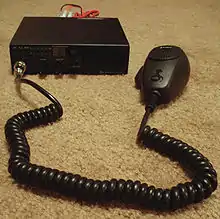Push-to-talk
Push-to-talk (PTT), also known as press-to-transmit, is a method of having conversations or talking on half-duplex communication lines, including two-way radio, using a momentary button to switch from voice reception mode to transmit mode.

History in two-way radio
For example, an air traffic controller usually talks on one radio frequency to all aircraft under his/her supervision. Those under the same frequency can hear others' transmissions while using procedure words such as "break", "break break" to separate order during the conversation (ICAO doc 9432). In doing so, they are aware of each other's actions and intentions, and do not hear any background noise from the ones who are not speaking. Similar considerations apply to police radio, the use of business band radios on construction sites, and other scenarios requiring coordination of several parties. Citizens Band is another example of classic push-to-talk operation.
The PTT switch is most commonly located on the radio's handheld microphone, or for small hand-held radios, directly on the radio. For heavy radio users, a PTT foot switch may be used, and also can be combined with either a boom-mounted microphone or a headset with integrated microphone.
Less commonly, a separate hand-held PTT switch may be used. This type of switch was historically called a pressel.[1][2]
In situations where a user may be too busy to handle a talk switch, voice operated switches are sometimes employed. Some systems use PTT ID to identify the speaker.
Manufacturers now make units specifically designed for PTT over cellular (POC or PoC). The largest supplier in the UK is 'Push To Talk International' who have supplied both handsets and vehicle units worldwide. Motorola is a popular communications supplier in the United States who offers PPT and PoC two-way radios in their line of product offerings. [3]
Mobile phones
Push-to-talk over cellular (PoC) is a service option for a cellular phone network that enables subscribers to use their phones as walkie-talkies with unlimited range. A typical push-to-talk connection connects almost instantly. A significant advantage of PTT is the ability for a single person to reach an active talk group with a single button press; users need not make several telephone calls to coordinate with a group.
Push-to-talk cellular calls similarly provide half-duplex communications — while one person transmits, the other(s) receive. This combines the operational advantages of PTT with the interference resistance and other virtues of mobile phones.
Current use in mobile telephony
Mobile push-to-talk services, offered by some mobile carriers directly as well as by independent companies, adds PTT functionality to smartphones and specialized mobile handsets (hand portable and mobile/base station PTT Radio Terminals). In addition to mobile handsets, some services also work on a laptop, desktop, and tablet computers.
Smartphone and computer apps
Recent development in PTT communications is the appearance of apps on smartphones, some of which can function on multiple platforms. Wireless carrier-grade PTT systems have adapted to and adopted the smartphone platform by providing downloadable apps that support their PTT systems across many mobile platforms. Over-the-top (OTT) applications are not dependent on a specific carrier and nearly as fast as carrier implementations.
See also
References
- "pressel". Wordnik.
- "Definition of pressel". Findwords.com.
- "PPT and PoC two-way radios". Day Wireless.
